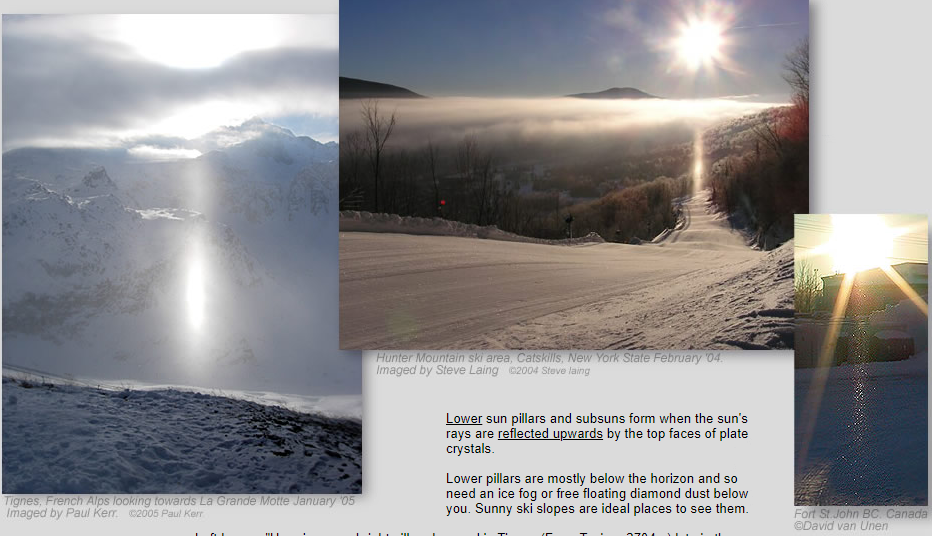Lower Sun Pillars & Subsuns
Lower Sun Pillars & Subsuns: An Enchanting Display of Atmospheric Optics
Lower sun pillars and subsuns are captivating atmospheric phenomena that occur when the sun's rays are reflected upwards by the top faces of plate crystals. These mesmerizing optical displays can be observed in certain conditions and locations, adding a touch of magic to the sky. In this article, we will delve deeper into the world of lower sun pillars and subsuns, exploring their formation, ideal viewing conditions, and showcasing stunning images captured by avid sky watchers.
Formation of Lower Sun Pillars and Subsuns
Lower sun pillars and subsuns owe their existence to the interaction between sunlight and ice crystals in the atmosphere. When the sun is low on the horizon, its rays pass through ice fog or free-floating diamond dust particles suspended below the observer. These tiny ice crystals act as mirrors, reflecting the sunlight upwards towards the observer's eyes. The result is a remarkable pillar of light extending vertically from the sun's position, creating an awe-inspiring sight.
Ideal Viewing Conditions
To catch a glimpse of lower sun pillars and subsuns, specific atmospheric conditions must align. Here are some key factors that contribute to optimal viewing opportunities:
- Ice Fog or Diamond Dust: Lower sun pillars and subsuns require the presence of ice fog or diamond dust below the observer. Ice fog consists of tiny ice particles suspended in the air, while diamond dust refers to small ice crystals drifting through the atmosphere. These atmospheric phenomena often occur in extremely cold environments.
- Below the Horizon: Lower pillars are typically situated below the horizon, making it necessary to find a vantage point where the observer can look downwards. Ski slopes bathed in sunlight provide an excellent location for witnessing this captivating optical phenomenon.
Captivating Images of Lower Sun Pillars and Subsuns
Now, let us take a moment to appreciate the beauty of lower sun pillars and subsuns through the lens of talented photographers who have captured these enchanting moments:
-
Bright Pillar in Tignes: In Tignes, a picturesque ski resort, Paul Kerr captured a stunning image of a radiant lower sun pillar. The pillar, observed from Toviere at an elevation of 2704 meters, illuminated the late afternoon sky, leaving spectators in awe.
-
Frozen "Fog" at Hunter Mountain: Steve Laing's photograph showcases a beautiful day at Hunter Mountain ski area in New York. With a strong inversion and temperatures hovering around 10 degrees Fahrenheit, the valley was filled with a frozen "fog." This ethereal mist, visible to the naked eye as sparkling particles floating through the air, created a mesmerizing backdrop for the lower sun pillar.
Conclusion
Lower sun pillars and subsuns offer us a glimpse into the fascinating world of atmospheric optics. These captivating optical displays are formed when sunlight interacts with ice crystals suspended in the atmosphere. To witness the enchantment of lower sun pillars and subsuns, one must seek out ideal viewing conditions, such as ice fog or diamond dust below the observer and a location where the pillars are situated below the horizon. The images captured by passionate sky watchers serve as a testament to the beauty and wonder that can be found in our ever-changing skies. So, next time you find yourself in a sunny ski resort or an environment with freezing temperatures, keep your eyes peeled for these extraordinary celestial phenomena that grace our world with their magical presence.

Lower sun pillars and subsuns form when the sun's rays are reflected upwards by the top faces of plate crystals.
Lower pillars are mostly below the horizon and so need an ice fog or free floating diamond dust below you. Sunny ski slopes are ideal places to see them.
Left Image: "Here is a very bright pillar observed in Tignes (From Toviere 2704m) late in the afternoon of 28/1/05 looking towards La Grande Motte. It was extremely cold." - Paul Kerr.
Centre: "Yesterday morning (Feb 2, 2004) at Hunter Mountain ski area in New York was a beautiful day with a strong inversion, and about 10 degrees F at the location of the photo. The valley was filed with a frozen "fog" which was visible with the naked eye as fine sparkles drifting through the air." - Steve Laing.
Right: Larger images 1, 2.
Note: this article has been automatically converted from the old site and may not appear as intended. You can find the original article here.
Reference Atmospheric Optics
If you use any of the definitions, information, or data presented on Atmospheric Optics, please copy the link or reference below to properly credit us as the reference source. Thank you!
-
<a href="https://atoptics.co.uk/blog/lower-sun-pillars-subsuns/">Lower Sun Pillars & Subsuns</a>
-
"Lower Sun Pillars & Subsuns". Atmospheric Optics. Accessed on November 26, 2024. https://atoptics.co.uk/blog/lower-sun-pillars-subsuns/.
-
"Lower Sun Pillars & Subsuns". Atmospheric Optics, https://atoptics.co.uk/blog/lower-sun-pillars-subsuns/. Accessed 26 November, 2024
-
Lower Sun Pillars & Subsuns. Atmospheric Optics. Retrieved from https://atoptics.co.uk/blog/lower-sun-pillars-subsuns/.